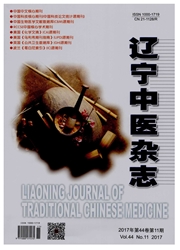

 中文摘要:
中文摘要:
目的:为了研究丹参酮ⅡA(TanshinoneⅡA,TSN)对免疫性肝损伤的保护作用及T淋巴细胞亚群在其中的作用。方法:丹参酮ⅡA大、中、小剂量组(30、20、10mg/kg)预防性给药15天,尾静脉注射20mg.kg-1刀豆蛋白A(Co-nA)损伤小鼠肝脏。采用自动生化分析仪测定血清中谷草转氨酶(AST)、谷丙转氨酶(ALT)的活性;通过FACSCalibur流式细胞术测定全血中CD3+、CD4+、CD8+T细胞亚群,并以ELISA方法测定血清中细胞因子小鼠肿瘤坏死因子(TNF-α)和小鼠γ干扰素(IFN-γ)的水平。结果:丹参酮ⅡA各剂量组均能降低ConA介导的肝损伤小鼠血清中AST、ALT的水平,以大剂量(丹参酮ⅡA30mg/kg)最为显著,(P〈0.01);丹参酮ⅡA各剂量组均能降低肝损伤模型组中已升高的炎性细胞因子IFN-γ和TNF-α的含量,(P〈0.05,P〈0.01);丹参酮ⅡA各剂量组均能提高肝损伤模型组中已降低的T细胞亚群CD3+、CD4+、CD8+的比率,(P〈0.05,P〈0.01),其中以大剂量(丹参酮ⅡA30mg/kg)最为显著,(P〈0.01)。结论:丹参酮ⅡA对免疫性肝损伤具有保护作用,其作用机制可能与丹参酮ⅡA通过调整T细胞亚群的活性和减少炎性细胞因子的作用有关。
 英文摘要:
英文摘要:
Objective:To Observe protective effective of Tanshinone IIA(TSN)on immunological liver injury in mice induced by concanavalin-A(ConA)and the role of T lymphocyte subsets in which.Methods:TSN divided into large dose group,middle dose group and small dose group(30、20、10mg/kg).In addition to the normal and model group given normal saline orally,all mice in other groups to give the corresponding drugs,after 15d,Apart from the normal control group all the rest group mice were injected with ConA 20mg/kg via the tail vein to damage mice′s liver.Using automatic biochemical analyzer,the serum′s alanine aminotransferase(ALT)and aspartate aminotransferase(AST)in mice were examined.The percentage of T lymphocyte subsets CD+_3、CD+_4、CD+_8 cells were detected in plasma by a FACSCalibur flow cytometer,Using ELISA for determination the serum cytokines:interferon-gamma(IFN-γ)and tumor necrosis factor alpha(TNF-α).Results:The activity of AST and ALT of TSN dose treatment groups significantly dropped in mice of ConA-mediated liver injury to be present dose-dependent;TSN-treated large dose groups could significantly reduced the liver injury model group had elevated inflammatory cytokines IFN-γ or TNF-α level(P0.05,P0.01);TSN dose groups could improve the liver injury model group had lowed T-cell subsets CD+_3、CD+_4、CD+_8 ratio(P0.05,P0.01),which in large doses(TSN30mg/kg) the role were most significant.Conclusion:Tanshinone IIA is effective in protecting immunological liver injury in mice induced by ConA and this mechanism maybe closely associated with its action in regulating the T-cell subsets and in reducing the inflammatory cytokines.
 同期刊论文项目
同期刊论文项目
 同项目期刊论文
同项目期刊论文
 期刊信息
期刊信息
